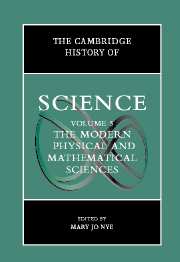Book contents
- Frontmatter
- Introduction: The Modern Physical and Mathematical Sciences
- Part I The Public Cultures of the Physical Sciences After 1800
- Part II Discipline Building in the Sciences: Places, Instruments, Communication
- Part III Chemistry and Physics: Problems Through the Early 1900s
- 11 The Physical Sciences in the Life Sciences
- 12 Chemical Atomism and Chemical Classification
- 13 The Theory of Chemical Structure and its Applications
- 14 Theories and Experiments on Radiation from Thomas Young to X Rays
- 15 Force, Energy, and Thermodynamics
- 16 Electrical Therory and Practice in the Nineteenth Century
- Part IV Atomic and Molecular Sciences in the Twentieth Century
- Part V Mathematics, Astronomy, and Cosmology Since the Eighteenth Century
- Part VI Problems and Promises at the End of the Twentieth Century
- Index
- References
16 - Electrical Therory and Practice in the Nineteenth Century
from Part III - Chemistry and Physics: Problems Through the Early 1900s
Published online by Cambridge University Press: 28 March 2008
- Frontmatter
- Introduction: The Modern Physical and Mathematical Sciences
- Part I The Public Cultures of the Physical Sciences After 1800
- Part II Discipline Building in the Sciences: Places, Instruments, Communication
- Part III Chemistry and Physics: Problems Through the Early 1900s
- 11 The Physical Sciences in the Life Sciences
- 12 Chemical Atomism and Chemical Classification
- 13 The Theory of Chemical Structure and its Applications
- 14 Theories and Experiments on Radiation from Thomas Young to X Rays
- 15 Force, Energy, and Thermodynamics
- 16 Electrical Therory and Practice in the Nineteenth Century
- Part IV Atomic and Molecular Sciences in the Twentieth Century
- Part V Mathematics, Astronomy, and Cosmology Since the Eighteenth Century
- Part VI Problems and Promises at the End of the Twentieth Century
- Index
- References
Summary
The nineteenth century saw enormous advances in electrical science, culminating in the formulation of Maxwellian field theory and the discovery of the electron. It also witnessed the emergence of electrical power and communications technologies that have transformed modern life. That these developments in both science and technology occurred in the same period and often in the same places was no coincidence, nor was it just a matter of purely scientific discoveries being applied, after some delay, to practical purposes. Influences ran both ways, and several important scientific advances, including the adoption of a unified system of units and of Maxwellian field theory itself, were deeply shaped by the demands and opportunities presented by electrical technologies. As we shall see, electrical theory and practice were tightly intertwined throughout the century.
EARLY CURRENTS
Before the nineteenth century, electrical science was limited to electrostatics; magnetism was regarded as fundamentally distinct. In the 1780s, careful measurements by the French engineer Charles Coulomb established an inverse-square law of attraction and repulsion for electric charges, and electrostatics occupied a prominent place in the Laplacian program, based on laws of force between hypothetical particles, then beginning to take hold in France. The situation was soon complicated, however, by Alessandro Volta’s invention in 1799 of his “pile,” particularly as attention shifted from the pile itself to the electric currents it produced. Much of the history of electrical science in the nineteenth century can be read as a series of attempts to come to terms with the puzzles posed, and the opportunities presented, by currents like those generated by Volta’s pile.
- Type
- Chapter
- Information
- The Cambridge History of Science , pp. 311 - 328Publisher: Cambridge University PressPrint publication year: 2002
References
- 1
- Cited by

